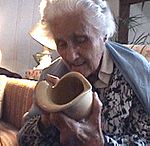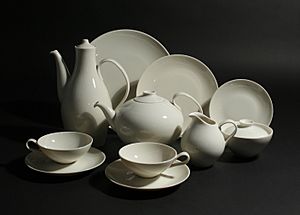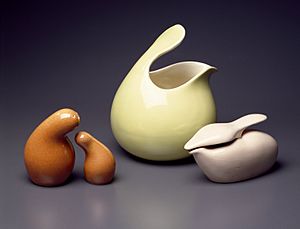Eva Zeisel facts for kids
Quick facts for kids
Eva Zeisel
|
|
|---|---|
 |
|
| Born | November 13, 1906 Budapest, Hungary
|
| Died | December 30, 2011 (aged 105) |
| Occupation | Industrial designer |
Eva Striker Zeisel (born Éva Amália Striker; November 13, 1906 – December 30, 2011) was a famous designer. She was born in Hungary and later became an American citizen. Eva Zeisel was best known for her amazing work with ceramics, especially after she moved to the United States.
Her designs often look like shapes from nature or human relationships. You can find her work in important museums all over the world. Eva Zeisel always said she was a "maker of useful things."
Contents
Eva Zeisel's Life Story
Growing Up in Hungary
Eva Zeisel was born in Budapest, Hungary, in 1906. Her family was wealthy and very educated. Her mother, Laura Polányi Striker, was a historian. She was the first woman to earn a PhD from the University of Budapest. Eva's uncles, Karl Polanyi and Michael Polanyi, were also very well-known thinkers.
Learning to Design
Even though her family was famous for science, Eva loved art. When she was 17, she started studying painting at the Hungarian Royal Academy of Fine Arts. To help pay for her painting studies, she decided to learn a more practical skill. She became an apprentice to Jakob Karapancsik, who was the last master potter in a very old guild system.
From him, she learned how to make ceramics. She was the first woman to become a qualified journeyman in the Hungarian Guild of Potters. After finishing her training, she worked at a ceramic workshop in Germany.
Early Career and Challenges
In 1928, Eva became a designer for a factory in Germany called Schramberger Majolikafabrik. For about two years, she created many fun, geometric designs for dishes, tea sets, and other ceramic items. Her designs were inspired by modern buildings.
In 1932, at age 26, Eva decided to visit the Soviet Union. She stayed there for five years. She worked in the Russian ceramics industry, inspecting factories and designing for large porcelain factories. She even became the artistic director of the Russian China and Glass Trust.
However, in May 1936, Eva was arrested in Moscow. She was wrongly accused of a serious crime. She was held in prison for 16 months, with 12 of those months spent alone. In September 1937, she was sent to Vienna, Austria. Some of her experiences in prison inspired the famous book Darkness at Noon, written by her childhood friend, Arthur Koestler.
While in Vienna, she met her future husband, Hans Zeisel, again. He later became a professor. Just a few months after she arrived in Vienna, political troubles began. Eva took the last train out of the city. She and Hans met in England, got married, and then sailed to the United States.
Designing in the United States (1937–1960s)
When Eva Zeisel arrived in the US, she had to start fresh to build her reputation as a designer. In 1937, she began teaching at Pratt Institute in New York. She and her students created designs for different companies.
In 1942, the Museum of Modern Art (MoMA) asked Eva to design a modern set of porcelain dishes. These dishes would be shown at MoMA and then sold. The exhibition, "New Shapes in Modern China Designed by Eva Zeisel," was held in 1946. It was the first time MoMA had a solo exhibition for a woman designer.
Her dishes, known as "Museum" and "Castleton White," were very popular. They were made and sold for many years. Eva said this project helped her become known as a top designer in the US.
The success of "Museum" led to another important project. Red Wing Pottery asked her to design dishes that felt "Greenwich-Villagey." She created the very popular "Town and Country" line in 1947. This set includes the famous "mother and child" salt and pepper shakers.
Around 1949–1950, Eva designed her most popular line, "Hallcraft, Tomorrow's Classic," for the Hall China Company. This was a full set of dinnerware and accessories. In 1955, she designed another line for Hall called "Century." In the late 1950s, she also designed for companies in other countries.
Later Designs (1980s–2011)
Eva Zeisel took a break from designing during the 1960s and 1970s. She worked on writing projects about American history.
She returned to design work in the 1980s. Many of her later designs were just as successful as her earlier ones. She created glassware, ceramics, furniture, and lamps for various companies. She also designed rugs, flatware, and even a coffee table.
In 2000, she designed a bone china tea set. In 2010, she released new designs for a lounge chair and salt and pepper shakers. After she passed away, new glass lamps based on her designs were introduced in 2012. In 2017, a company created felt wall tiles based on her designs. Reproductions of her earlier designs are also sold in museum gift shops.
Eva Zeisel's Design Style
Eva Zeisel's designs were always made to be used. She often found inspiration for her soft, curvy shapes from the human body. Her use of shapes, colors, and bird themes showed influences from the Hungarian folk art she grew up with.
Most of Eva's designs, whether made from wood, metal, glass, or ceramics, were created in "family groups." Many of her designs fit together, which helps save space.
Eva described her designs in a newspaper article: "I don’t create angular things. I’m a more circular person—it’s more my character….even the air between my hands is round."
Among her most famous shapes are the unique, curvy "Town and Country" dishes. These were made by Red Wing Pottery in 1947. This set includes the well-known "mother and child" salt and pepper shakers.
Eva Zeisel's Family Life
Eva Zeisel had two children with her husband, Hans: a daughter named Jean, born in 1940, and a son named John, born in 1944. In a documentary about Eva Zeisel, her children talked about their parents' strong personalities. They said this sometimes led to "a collision of forcefields."
Museums and Exhibitions
Eva Zeisel's artwork is part of the permanent collections in many famous museums. These include the Metropolitan Museum and the Museum of Modern Art in New York. Her work is also in the British Museum and the Victoria and Albert Museum in London. You can find her designs in museums in Germany, Dallas, Chicago, Atlanta, and Milwaukee, among many others.
In the 1980s, a large exhibition of her work traveled through the US, Europe, and Russia. In 2004, another important exhibition called "Eva Zeisel: The Playful Search for Beauty" was shown in several museums.
From 2005 to 2007, the Erie Art Museum had a long-term exhibition called "Eva Zeisel: The Shape of Life." In 2006, the Mingei International Museum in San Diego opened a big exhibition celebrating her 100th birthday. It showed her designs from 1928 all the way to her more recent work.
Awards and Honors
In 2005, Eva Zeisel received the Lifetime Achievement award from the Cooper-Hewett National Design Museum. She also received two of the highest awards for civilians from the Hungarian government. She won awards from the Industrial Designers Society of America and Alfred University.
She was an honorary member of the Royal Society of Industrial Designers. She also received honorary degrees from several well-known art and design schools.
See also
 In Spanish: Eva Zeisel para niños
In Spanish: Eva Zeisel para niños



